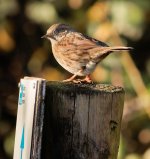Hi Colstar - Dunnocks are insect eaters, hence the thin bill, whereas House Sparrows are mainly seedeaters, so they need a much stronger bill to break open the husks. They are generally more skulking, hunting under the hedges, House Sparrows usually sit on top of the hedge in groups.
The bill is often the first thing you need to look at, when trying to identify a bird as it will often point you to a family so you can work out which one it is.
Plumage - Dunnock has black streaking in amongst the brown; House Sparrows more buffish streaks, any black bits ary more like small blobs. The head, though pale, isn't really 'grey' and they don't have the grey collar. The pink legs which Welsh Peregrine highlighted, are really very distinctive on the Dunnock (with the light behind them, they really glow!). House Sparrow legs are really pale brown and really not noticeable at all LOL.

www.birdforum.net

www.birdforum.net
It's generally the female that causes the confusion. The male House Sparrow is very distinctive.
Hope this helps.








